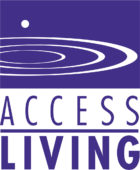In Conclusion
More than 85 million people in the United States ages 18 to 65 have a disability.[76] It is reported that an estimated 40 percent of people in jail have at least one disability,[77] though we presume this is an underestimate due to the difficulties in tracking disability within the criminal justice system. The overrepresentation of people with disabilities in jail should spark thoughtful conversations in the efforts to reduce jail incarceration.
Overall during the course of our project, we learned that several steps can be taken to move forward the ongoing dialogue about reducing harm to people with disabilities in the criminal justice system, and improving communication and access. This report is a look into ways to implement change through a framework, the cross-disability lens, that is both vital and not always at the forefront of criminal justice reforms. Based on what we have learned to date, Access Living believes that through focusing on the voices of impacted community members, providing robust cross-disability support and guidance to policymakers, and investing in non-incarcerative community supports, it is possible to further reduce the unnecessary incarceration of people with disabilities.
We are grateful for the support and teaching of many community leaders, disability activists and criminal justice stakeholders throughout the formation of this report. Although our report is unlikely to be fully inclusive of all community needs, we see it as a starting point for Access Living, and we invite stakeholders to consider the recommendations presented and the noteworthy ideas and models highlighted, to expand collaboration moving forward.
